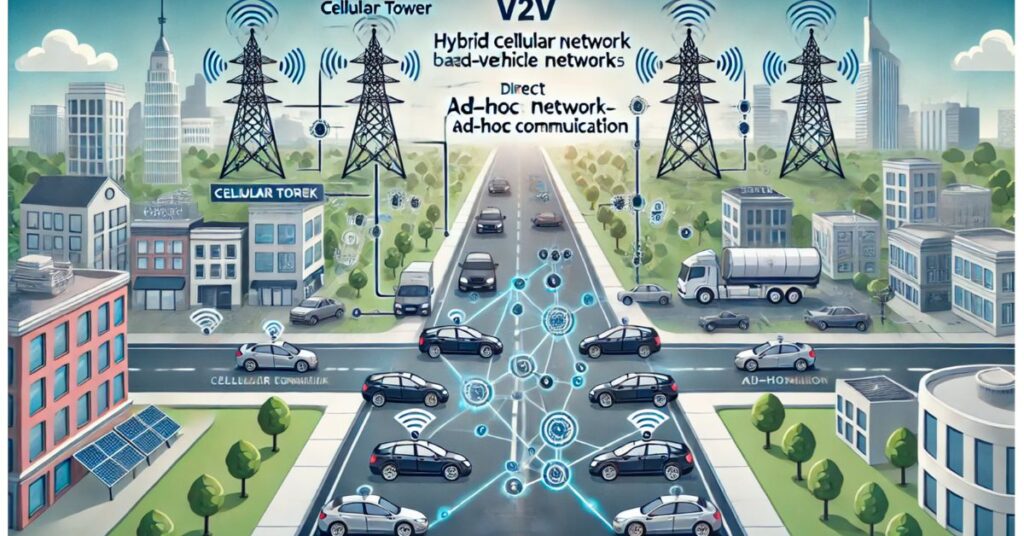In the world of connected mobility, Vehicle-to-Vehicle (V2V) communication is quickly becoming a key player. It holds great promise for reducing road accidents, easing congestion, and making travel safer and more efficient.
While self-driving cars and AI tend to grab headlines, V2V works quietly in the background. It lays the foundation for a more cooperative driving environment. Vehicles communicate with each other in real time, sharing data on speed, location, and hazards.
This constant exchange of information helps prevent a range of critical problems on the roads, from collisions to traffic delays. It represents a major step forward in building a smarter, more responsive, and safer transportation system for everyone behind the wheel.
The Functioning of V2V Communication
Vehicle-to-Vehicle (V2V) communication enables cars to wirelessly exchange real-time data, enhancing safety and awareness on the road. Using technologies like Dedicated Short-Range Communications (DSRC) or Cellular-V2X (C-V2X), V2V-equipped vehicles automatically transmit Basic Safety Messages (BSMs) at frequent intervals.
These messages include details such as speed, location, direction, and braking status, and are shared with nearby vehicles. This constant flow of information helps detect hidden dangers, avoid collisions, and trigger timely alerts or automatic actions. According to the U.S. Department of Transportation, V2V could prevent up to 80% of crashes involving alert drivers.
When combined with Vehicle-to-Infrastructure (V2I) systems, the network becomes even stronger. It can connect with traffic signals, road signs, and sensors, creating a smarter and more responsive driving environment.
How V2V Technology Helps Solve Major Traffic Issues
V2V is far more than a futuristic gimmick; it directly tackles many of today’s most pressing traffic safety challenges. Here are some of the key problems it helps address:
Pothole-Related Accidents
In cities like St. Louis, Missouri, where potholes are a year-round problem, Vehicle-to-Vehicle (V2V) technology could be a game changer. When a car hits a pothole or detects it through shock and vibration sensors, it instantly shares the data with nearby vehicles. This real-time alert helps others slow down, change lanes, or reroute, potentially avoiding damage or dangerous crashes.
Unlike accidents caused by poor visibility or intersection errors, pothole-related incidents often result from prolonged neglect by local authorities. While timely repairs should be a civic priority, cities like St. Louis have struggled to keep up.
If you’re injured due to a pothole or because another driver swerved to avoid one, don’t ignore it. A St. Louis car accident attorney can help determine if you’re eligible for compensation.
According to TorHoerman Law, they can gather evidence, navigate local liability laws, and negotiate with insurers on your behalf. In many cases, the city or relevant agency could be held responsible, and you may be entitled to compensation.
Rear-End Collisions
Rear-end collisions are among the most common types of traffic accidents, often resulting from delayed human reaction times and limited visibility. In fast-moving or congested traffic, drivers often depend on visual cues to react. Usually, they rely on the brake lights of the vehicle directly in front to know when to slow down.
However, this creates a reactive driving environment that can lead to chain-reaction crashes when multiple vehicles are involved. Vehicle-to-Vehicle (V2V) technology fundamentally changes this dynamic by enabling cars to exchange real-time data wirelessly, including speed, acceleration, and braking activity.
This means your vehicle can receive alerts not just from the car ahead, but also from vehicles two or three cars up the line. By detecting sudden deceleration farther ahead than the human eye can see, V2V gives your car and you critical extra seconds to react.
Intersection Crashes
Intersections are among the most dangerous parts of the road network, responsible for a disproportionately high number of accidents. According to the Federal Highway Administration, nearly one-quarter of all traffic fatalities in the U.S. happen at intersections. Additionally, about half of all traffic-related injuries occur in these areas.
These crashes are often caused by limited visibility, driver error, or failure to obey traffic signals. V2V technology offers a powerful solution by enabling vehicles to “see” one another through wireless communication. This works even when the line of sight is blocked by buildings, trees, or other obstacles.
For example, if an oncoming vehicle is about to run a red light or make a risky left turn, your car can detect it. That data is received instantly through V2V communication. It can then either warn you or automatically apply the brakes.
Low-Visibility Driving Hazards
Fog, rain, and snow are common weather conditions across much of the United States, particularly during seasonal transitions and winter months. These low-visibility situations aren’t rare; they affect millions of drivers every year and are a major contributor to roadway accidents. Fog alone accounts for over 38,700 vehicle crashes annually, according to federal data.
One of the primary dangers in such conditions is increased speed variance. While some drivers slow down cautiously, others continue at unsafe speeds, creating a dangerous mismatch that raises the risk of crashes.
V2V communication adds a crucial layer of safety in poor weather conditions. The system creates a “virtual awareness bubble” around each vehicle. It helps fill in the gaps when drivers can’t see clearly. They can respond quickly by warning the driver or adjusting speed, or braking automatically.
Traffic Jams and Road Congestion
Traffic congestion remains a major issue in cities across the U.S., wasting both time and money. According to Commercial Carrier Journal, in 2024 alone, the average driver lost 43 hours sitting in traffic. It’s about the equivalent of a full work week. This delay cost individuals an estimated $771 in lost time and productivity. On a national scale, that adds up to more than four billion hours and $74 billion in economic losses.
V2V communication can help ease this burden. When vehicles share real-time data on speed, location, and road conditions, cities gain valuable insights into traffic flow. This information can be used to adjust traffic lights more efficiently, detect congestion early, and suggest alternative routes.
These adjustments are especially helpful during rush hour or major events, when gridlock is most severe. By improving traffic coordination through data sharing, V2V can help cities reduce delays, lower fuel waste, and improve the overall commuter experience.
FAQs
How does V2V communication handle data privacy and security?
V2V systems are designed with privacy and security at the core. Vehicles don’t transmit personal data like VINs or driver identity. Instead, they use anonymous, frequently changing digital identifiers. Additionally, data is encrypted and verified using a Security Credential Management System (SCMS) to prevent spoofing or tampering.
Can older vehicles be upgraded with V2V technology?
Yes, through aftermarket V2V retrofit kits. These systems can be installed in older vehicles to enable basic communication functions like hazard alerts and location sharing. However, the level of integration may not be as advanced as that of factory-installed systems in newer vehicles.
How does V2V communication perform in rural or low-connectivity areas?
Since V2V relies primarily on direct short-range wireless signals (not cellular networks), it works reliably even in remote or low-connectivity areas. Vehicles can still exchange safety messages locally without needing internet access or strong cellular coverage.
Overall, V2V communication may not be as flashy as self-driving cars or flying taxis. However, it’s quietly becoming the nervous system of tomorrow’s transportation network. Whether it’s avoiding a deadly collision at an intersection or getting a heads-up about a pothole ahead, V2V makes a real difference. It has the power to turn every drive into a safer, smarter journey.
As we move toward a more connected and cooperative driving future, Vehicle-to-Vehicle communication is no longer optional; it’s essential.
Also Read: Unveiling Edivawer: A Mysterious Digital Entity or a Rising Tech Platform?

